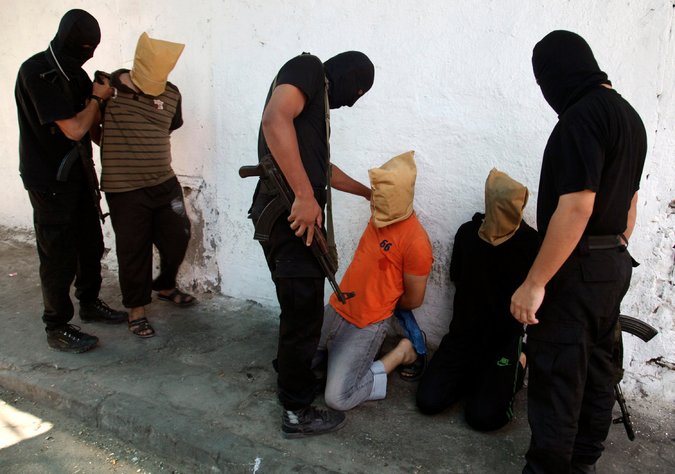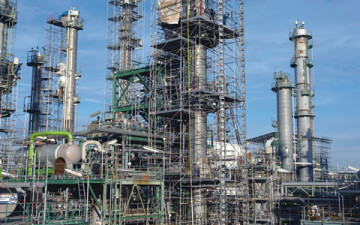GAZA CITY — One day after an intelligence coup enabled Israel to kill three top commanders of Hamas’s armed wing, as many as 18 Palestinians suspected of collaboration with Israel were summarily executed in public on Friday, in what was seen as a warning to the people of the Gaza Strip.
Masked gunmen in matching black T-shirts and pants paraded seven of the suspected collaborators, handcuffed and hooded, to their deaths before a boisterous crowd outside a downtown mosque after noon prayers, in a highly theatrical presentation. Photographs showed a pair of militants leaning over a doomed man on his knees against a wall, and masses of men and boys cheering and clamoring for a better view.
The Palestinians killed on Friday were not identified, but they were reported to have been arrested for or convicted of collaboration, a crime punishable by death under Palestinian law, before this summer’s bloody battles between Israel and Hamas, the militant Islamist movement that dominates Gaza.
Still, the style and timing — after Thursday’s Israeli airstrikes that killed the three Hamas commanders and the attempted assassination on Tuesday night of their boss, Mohammed Deif, whose fate remains unknown — indicated an intensified Hamas crackdown against those who inform on leaders’ locations.
“I think this has provoked, and let’s say triggered, this process,” said Hamdi Shaqqura, deputy director of the Palestinian Center for Human Rights, a Gaza group that has long monitored and condemned such extrajudicial killings. “If you speak to any regular citizen in Gaza, nobody is looking with mercy on these people. Why? Because people are being bombarded. A lot of the blame for bombardment of specific places is being put on collaborators.”
Al Majd, a website managed by the Internal Security Service of the Hamas government that ran Gaza until June, warned that future collaborators would be dealt with in the field, not in courthouses, to create deterrence.
The executions, the most public and numerous since the simmering Gaza conflict sharply escalated on July 8, came amid the third consecutive day of heavy rocket and mortar fire from Gaza into Israel. One mortar shell killed a 4-year-old boy on a kibbutz just outside Gaza, the first child and fourth civilian in Israel to die in the escalation, which has taken the lives of 64 Israeli soldiers and nearly 2,100 Palestinians, about 500 of them children.
The Israeli military said the shell had been fired from a Gaza City school used to shelter Gazans displaced by the fighting.
Prime Minister Benjamin Netanyahu of Israel vowed in a statement that “Hamas will pay a dear price for this severe terror attack,” and he said his forces “will intensify their activity” until the operation’s objective — restoring quiet — “is achieved.”
The Israeli military counted more than 120 rockets fired by 10 p.m. Friday, some sailing as far north as Tel Aviv and its suburbs, and nearly 500 since Tuesday afternoon, when a nine-day cease-fire and Egyptian-brokered talks toward a more durable truce collapsed. Five people were wounded, three by shrapnel from a rocket that exploded in a synagogue in Ashdod, a city not far from Gaza.
The Gaza Health Ministry said that a father and son had been killed in Qarara, near Khan Younis in southern Gaza, and that two others had died of wounds. More than 40 Gazans were wounded in an evening Israeli strike on a Gaza City home, the ministry said.
“We are currently attacking in the Gaza Strip very powerfully and will continue to do so in the coming hours,” Brig. Gen. Motti Almoz, the chief Israeli Army spokesman, said in a television interview on Friday night. “Every citizen in the Gaza Strip who has in proximity to him or his home weaponry, we view him to be a legitimate target,” General Almoz said. “We are asking him to leave the area because those targets are going to be attacked in the coming hours and coming days. We are here. We aren’t going to go anywhere until quiet arrives.”
The Friday executions, which followed the similar killings of three suspected collaborators reported by Palestinian news agencies on Thursday, echoed killings Hamas carried out during two previous Israeli military operations in Gaza. Gaza’s Interior Ministry, which handles judicial and security matters, declined to address the reported executions. But a statement published on many Palestinian websites — including some affiliated with Hamas — said a “revolutionary court” had been formed “in agreement with the war’s circumstances.”
Journalists, human rights workers and a witness said that either nine or 11 people, including two women, were killed Friday morning in a public park and at a bus stop near Al Azhar University in Gaza City, near the central prison where they were believed to have been held. Seven others, hands tied behind their backs, were killed as worshipers exited Al Omri mosque, another witness said, leaving bloodstains on the ground that bystanders photographed with mobile phones.
“There were about 20 masked gunmen in the area,” said the witness at the mosque, who spoke on the condition of anonymity for fear of reprisal. “One of them said loudly that the death sentence is going to be carried out against seven collaborators.”
“They did not mention their names,” he added. “They shot them after that, and then the militants left. People were shouting, ‘God is great.’ ”
Mr. Shaqqura of the human rights center said his group was investigating reports that five other suspected collaborators had been killed more than two weeks ago. Its director, Raji Sourani, wrote urgent letters to Palestinian leaders on Friday “demanding that they immediately and decisively intervene to stop such extrajudicial executions,” according to a statement.
“In the middle of this onslaught on Gaza, we are in need to respect the rule of law and to respect human rights,” Mr. Shaqqura said in an interview. “More than any other time, it’s a challenge for us.”
During Israel’s last Gaza offensive, in 2012, masked gunmen left the bloodied body of Ashraf Ouaida in a traffic circle beneath a billboard showing a Hamas fighter, and hung a poster around his neck that accused him of helping Israel kill 15 Palestinian leaders. A few days later, six more suspected collaborators were killed vigilante-style, and the body of one was dragged through a Gaza City neighborhood by motorcycle.
At least a dozen collaborators who escaped from Hamas jails during Israel’s invasion of 2008-9 were summarily executed in the street.
Collaboration has been considered a heinous crime in Palestinian society since before Israel became a state. During its seven-year rule of Gaza, Hamas used vigorous prosecution and the occasional lynchings of suspected spies to enforce loyalty. But rights groups that document such cases said the number had been radically reduced from the period from 1987 to 1994, when an estimated 1,000 people were executed as collaborators.
Hagai el-Ad, director of the Israeli human rights group B’tselem, declined to speculate on why Hamas might have chosen Friday to kill the collaborators.
“This is something that cannot be justified, full stop,” he said in an interview. “Such actions are severe violations of international humanitarian law, and those involved in such actions are personally, criminally liable.”
Sarah Leah Whitson, Middle East director of Human Rights Watch, called the killings “a horrendous abuse” and said “renewed efforts are needed so that trials in Gaza respect defendants’ rights.”
NYTimes.






